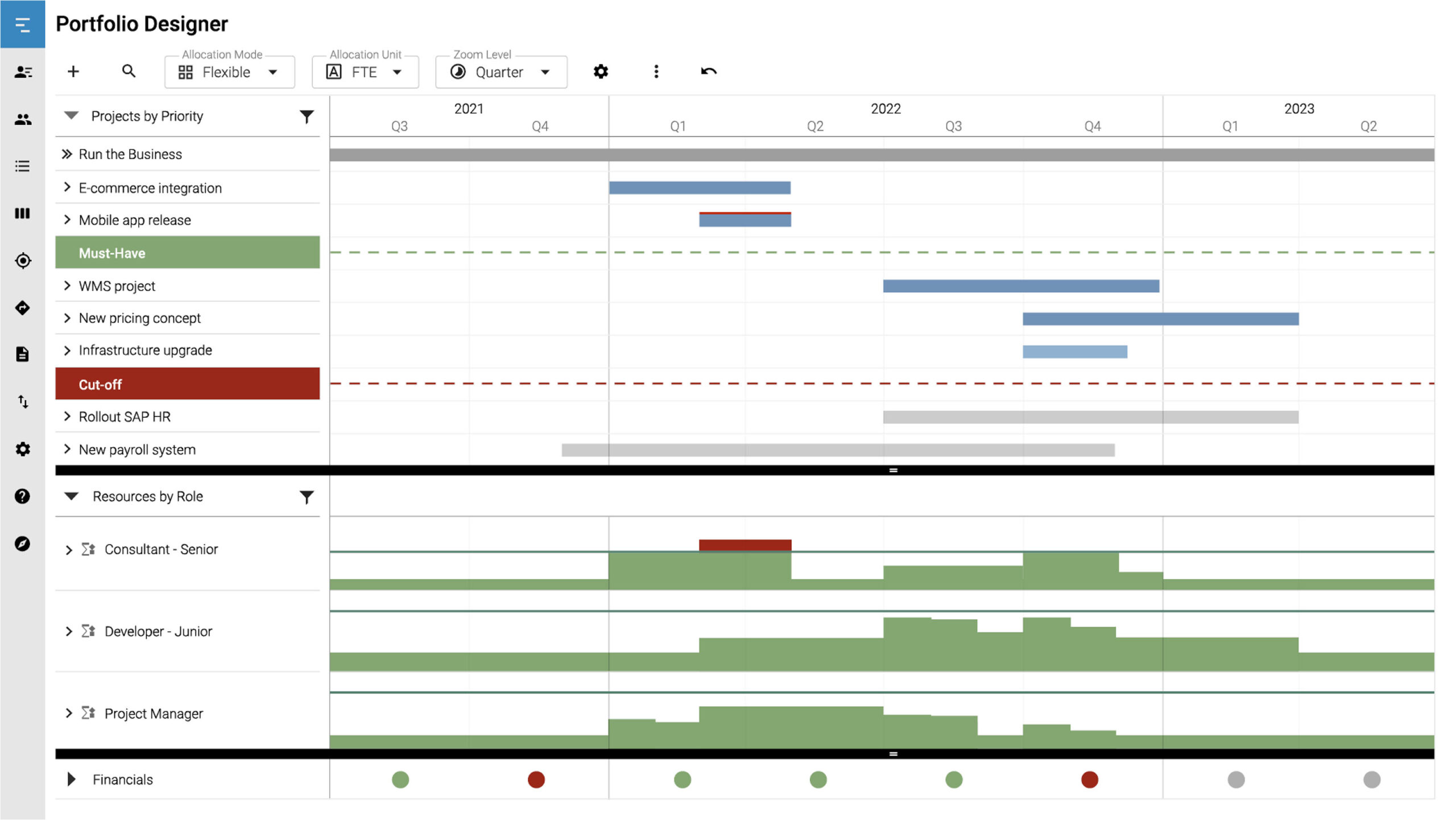In the dynamic realm of multi-project management, the quest for efficiency and productivity is unceasing. To navigate this complex domain successfully, one needs not only the right tools but also the right approach to change.
As the author of this article, I have had the privilege of gaining two decades of experience in the field, which has led me to distill a comprehensive and holistic approach for achieving better flow in multi-project management. In this detailed exploration, we’ll delve into the five crucial steps that constitute this approach and provide valuable insights into each of them.
Step 1: Laying the Foundation
Reducing Work in Progress
The foundation of efficient multi-project management lies in recognizing and addressing constraints. Constraints can be real, such as limited resources, or virtual, representing critical project phases. Identifying these constraints is the first step in setting the stage for streamlined multi-project management.
In practice, there is typically one constraint that stands out – if you focus on not overloading this, all the other constraints will disappear. In project environments, this one constraint is, in most cases, the previously mentioned virtual constraint – a critical project phase. This approach is based on the “Theory of Constraints” by E. Goldratt and used successfully all over the world by market leaders.
A critical concept in this step is adjusting the virtual drum’s capacity to ensure optimal resource availability for all projects. The virtual drum is a metaphor for the one constraint – the master pacemaker for the whole project organization. By making the constraint synonymous with the virtual drum, you are ensuring that all projects are aligned with it.
The concept of the “drum buffer rope” shown here actually comes from production and cannot be applied 1:1 to projects. However, it illustrates the clocking bottleneck nicely.
The primary goal of this step is to reduce work in progress. Due to the well-known “Little’s Law”, excessive work in progress leads to prolonged project lead times, and as a result, frequent disruptions and a cluttered and chaotic workflow. Little states that the project duration (lead time) is directly proportional to the work in progress divided by the output.
One of the remarkable outcomes of reducing work in progress is a substantial effect on lead time – a reduction of 50% of work in progress immediately results in ~50% decrease of project duration. This is valid, especially if you suffer from an overloaded constraint.
In practice the effects are even bigger. The work-in-progress reduction also leads to multitasking reduction, an issue that plagues many organizations. You can significantly enhance productivity by addressing multitasking. Reducing multitasking not only leads to a more focused and efficient workforce, but also helps minimize errors, thereby improving the overall quality of project delivery. Less multitasking, fewer mistakes, and better synchronization – this all leads to a reduction of the effort in the constraint and, due to Goldratt’s Law, leads directly to an increase in output – which, in turn, leads to another reduction of project lead time.
Step 2: Empowering Teams and Collaboration
Signal for Self-Organization
Efficiency and flow in multi-project management thrive on self-organization. Traditional hierarchical systems can often become bottlenecks, leading to delays in decision-making and project execution. To counter this, creating a signal that indicates operational priority becomes essential. This signal must be derived from the project itself, without the possibility of being influenced by a single person, and it must be helpful for practical purposes.
What is meant by the signal?
This signal can take various forms. In practice, the concept of progress versus buffer consumption out of the Critical Chain Project Management domain shows the best effects. It is easy to understand and directly shows the criticality of the project.
As long as the project consumes less buffer than generating progress, everything is green. If more buffer is consumed than progress made, it’s red. If it’s red, the team has all the power, financial resources, and allowance to bring it back to green. This signal is typically updated every day or at least two times per week.
But where does this buffer come from? One possible way is to plan the project “green field” or as “happy flow”. By planning with optimal assumptions, you need a buffer. Probability math and experience show that 50% of the duration of the longest “happy flow” chain of work packages is typically enough to cover all surprises. By planning like this, the project is no longer as planned in a classic way. The same goes for agile releases – just take the current backlog as the best case and add 50% buffer. These are rules of thumb and a good starting point.
Even more interesting is seeing the status of all projects based on progress versus buffer consumption to all employees in the form of a scatter plot. It provides clear visual cues to all teams about which projects and tasks require immediate attention. Self-organization kicks in when the organization allows the resources and the managers to support the red projects with attention, information, and resources.
This step fosters a culture of self-organization within the organization. When teams are adequately informed about their priorities, they can act swiftly and effectively. This approach empowers them to take ownership of their work and encourages them to help each other solve problems.
The outcome is a more agile and responsive project management system that allows for smoother collaboration among teams. Team over spanning collaboration is becoming reality! Everyone is pulling in the same direction, making the whole portfolio of projects successful.
Step 3: Systematic Evolution
Process Improvements and Root Cause Analysis
Normally all continuous-improvement-systems suffer from two problems :
- they try to improve all processes at once,
- and the measures to improve are planned on top of the daily and project work.
As a result, most improvement initiatives fail or show no result.
Once the foundation in steps 1 and 2 have been laid, the focus shifts to making systematic process improvements and conducting root cause analysis. After all, recognizing constraints and reducing work in progress is just the beginning and already shows positive effects – more capacity for improvements becomes available. It’s the consistent effort to enhance processes that yields lasting results.
This step begins by introducing a system for gathering data on buffer regain measures. Buffer regain measures (the ones to bring red projects into yellow or green again) provide valuable insights into how well the organization is functioning and can help identify the root causes of capacity overspending.
Typically, weekly workshops are crucial in systematically addressing these issues. By actively engaging with these obstacles and using the data collected, you can implement process improvements that lead directly to increased throughput and fewer operational disruptions. The emphasis is on reducing inefficiencies and eliminating flow disruptions. This needs top management attention and should be a top priority.
The primary goal…
…of this step is to ensure that the improvements made are sustainable. Process improvements should become part of the organizational culture, with teams continually seeking ways to optimize the workflow and quality in the constraint. By regularly monitoring progress and addressing the root causes of disruptions, you can maintain a state of continuous improvement.
Companies following these three steps typically gain an increase in throughput of 50% in the first months and factor 2-5 over the next two years.
Step 4: Gaining Top Management Support
How to Tell It to Your Boss
To implement operational improvement strategies successfully, it’s crucial to secure support from top management. However, convincing top management to endorse these strategies requires effective communication and a compelling business case.
The only way to convince top management is to calculate a business case that clearly demonstrates the potential benefits of operational improvements. It is the only language that top management understands – the language of numbers.
Consider a hypothetical example :
Current Sales: $100 million
Current Bottom Line: $5 million
Variable Costs : (50% of sales – typical for mechatronic products or special machinery. You can use a value that fits your business here; the 50% is just to show how it works)
With these figures, you can calculate the current operational expenses:
Operational Expenses must be: $45 million (sales – 50%totally variable costs – bottom line results = operational expenses))
Typically steps 1 to 3 generate 50+% more throughput. Assuming you can sell just 20% more, then the impact on the bottom line is already substantial. By increasing sales by 20% without raising operational expenses, your business case looks like this:
New increased Sales: $120 million
New Total Variable Costs: $60 million
Old Operational Expenses: $45 million – they stay the same
Bottom Line: $15 million
The result is a bottom-line increase from $5 million to $15 million, which is a remarkable threefold improvement. Many companies have achieved even greater results, quadrupling their bottom lines and more. This demonstrates the potential for dramatic changes through doing constraint-focused multi-project management as described above.
By presenting this business case to top management, you can gain their support. Frame the discussion around what you can sell with the increased capacity and how the remaining additional capacity can be used for cleanup and other initiatives. This approach helps top management see the tangible benefits of endorsing your operational improvement strategies.
Step 5: Fostering Collaboration
Get Middle Management on Board
Middle management is often the bridge between top management and the front-line teams. They are intimately familiar with the day-to-day challenges of workflow and are already motivated to improve the system. To harness this motivation and ensure that operational improvements are effectively implemented, a collaborative approach is necessary.
Instead of trying to convince middle management, invite them to a challenging one or two-day workshop. The goal of this workshop is to understand why the newly described approach will not work as expected. By conducting this workshop, you empower middle management to identify the obstacles – their daily work.

But because middle managers feel the pain and their daily routine is to find solutions, they will easily also find the solutions to overcome those obstacles. Companies often come up with 150 to 300 reasons why the system is not working efficiently. This process allows middle management to voice their concerns and issues openly and find the right solutions.
The workshop focuses on identifying the most significant obstacles first. Middle managers, being problem solvers themselves, always discover solutions and changes that need to be made during these discussions. The Masterplan of Change becomes visible and transparent. The master plan is built by the middle managers themselves – its theirs! This collaborative approach empowers them to take ownership of the process improvements.
One additional crucial aspect of this step is storytelling and emotional appeal. Discuss the emotional and personal benefits of the changes, emphasizing what’s in it for each individual. By highlighting how the changes will make their jobs easier and more fulfilling, you can gain the commitment of middle management.
Get consent
To gauge the organization’s readiness for change, use an anonymous thumbs-up/down vote at the end of the workshop. This vote is a visual representation that shows where participants stand regarding the proposed changes. Participants can mark their position towards the change on a chart to indicate their level of resistance or support. This process is conducted anonymously to encourage honest responses.
The goal is to reach a consensus of at least 90% thumbs up. This means that participants are willing to start implementing the changes. By achieving this consensus, you can ensure that the changes will be met with full support and collaboration from middle management. And in all cases where we conducted this workshop, the picture has always been the same – thumbs up!
Practical Implementation
Combine a Powerful Tool with Strong Support
The application of these principles is facilitated by project portfolio management tools like Meisterplan. These tools allow for unbuffered (optimistic) planning while incorporating a buffer for flexibility. Project tracking and time monitoring features enable real-time updates on project progress with the scatter plot.
For a successful implementation, steps 4 and 5, (the buy in of the top- and middle-management) are key. Supporters of the DolphinUniverse are willing to back this up.
Our recommendation:
A best-in-class tool like Meisterplan and a best-in-class support like DolphinUniverse will result in fast throughput increase and a boost in self-organization.
Want to delve deeper into the topic? Then be sure to take a look at my book: “Management 4.0 – Handbook for Agile Practices“. Chapter 10 in particular will give you even more insights into critical chain project management. A manager’s paradise and the key to the next career step.

Conclusion
A Holistic Approach to Excellence
Achieving better flow in multi-project management is a dynamic and holistic process. It involves not only the reduction of work in progress and increased self-organization, but also systematic process improvements, effective communication with top management, and active involvement of middle management.
When applied effectively, these five steps lead to dramatic improvements in project delivery and overall efficiency. The right approach, supported by your teams and leadership, can transform the challenges of multi-project management into opportunities for excellence.
The road to excellence in multi-project management is undoubtedly complex, but with the right approach, it can be a home run. By focusing on constraints, self-organization, process improvements, business case presentation, and middle management collaboration, you can unlock the full potential of your organization, streamline project execution, and achieve unparalleled efficiency.
In conclusion, remember that excellence is a journey, not a destination. As you embark on this journey, use the knowledge and insights shared in this article as your guide to mastering the art of achieving flow in multi-project management.



